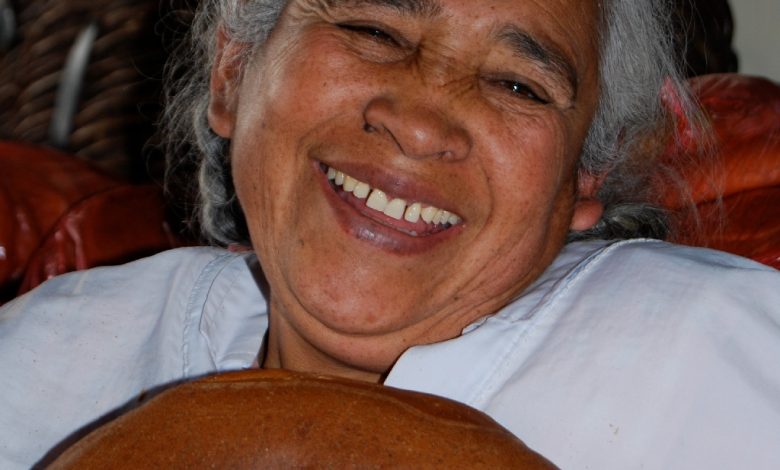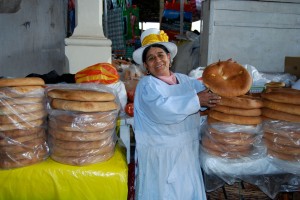Cuzco’s Traditional, Hand-Made Bread

While much of the world is caught in the pre-prepared uniformity of industrial breads (even those of the artisanal bread movement such as found in many US supermarkets and bakeries,) Cuzco has a long history of local breads deeply tied into local history and culture that has not been lost in the face of global standardization.
A big, round yet relatively flat, loaf — some 30 centimeters in diameter and five centimeters in height– can be found all over Cuzco. It is sold in the city’s markets, its bus and train terminals, and along busy streets, even if the supermarkets carry other bread preserved in sealed plastic wrap.
Interestingly, all this bread in Cuzco is made in a single place, the town of Oropesa 21 kilometers from Cuzco proper.
The bread is made traditionally from quality local wheat. But it also has a hint of sweetness from additional sugar, richness from egg, and hints of seasoning from spices and herbs such as cinnamon and anise. Sometimes it also carries raisins as well as other ingredients and seasonal and local decorations.
Special woods and eucalyptus leaves are burned in the traditional ovens and impart not only a crust and texture, but also a delicacy of flavor.

In Cuzco, this bread called pan chuta or bread from Oropesa, is a standard gift when one goes visiting in the rural communities around Cuzco. It symbolizes the affection and respect one has for the people who visit one. As such, it is very important in a society and economy built around people helping and trusting each other. It is a return for the love and respect implied in the visit itself.
It is also a gift one takes when one travels from Cuzco elsewhere. When one leaves Cuzco, one passes by the ladies in the bus terminal with their bags of pan chuta. And, if one goes through Oropesa, where the bread is made in some forty traditional ovens, ladies with bags stuffed with pan chuta either get on the bus to offer it for sale or crowd the car or bus to stuff bread through the windows in exchange for coins.
In this way, the bread carries the essence of the city of Cuzco and its nearby bakers of Oropesa far and wide.
Furthermore, bread is a gift given to the people carrying the burden of feasts within Cuzco. This is a special form of the pan chuta, with one on top of another, and symbolizes the burdens that the person carries on behalf of other people before the mountains and the saints. As such, it is very important.
Pan chuta also appears in rituals of courtship, such as when the two families come together, and in the rituals surrounding the death of a loved one.
But even more, the pan chuta, with its carefully created texture, light crust, and its delicate taste, is a daily accompaniment to the hot drinks Cuzqueños consume morning and night. It is the taste of Cuzco
Before modern cars, trucks, and buses, every night, shortly after midnight, teams of mules would set out for Cuzco. Heavily laden with baskets of fresh bread, they would reach the city before dawn to supply it with its bread. Even today, Oropesa continues as the almost exclusive bread supplier of the city, although the bread is now carried in gasoline driven vehicles and the drivers do not have to set out so early.
Of course, in the days of mule teams the mule drivers had many stories that contributed to the transcendence of this product of traditional bread makers. Drivers had stories of ghosts and people condemned to walk the earth in perennial desire for that which was lost. Somehow the bread, like a savior, would survive the gauntlet of the dead and unholy to make it to Cuzco by the time the sun crossed the horizon in order to bring leavened nourishment to the city’s residents.
But the transcendence also stems from the history of Oropesa, a town with an Inca past. It was the home of the resistant Pisaguas. After their conquest, it became a enter of royal Inca constructions, seen today in the nearby ruins of Tipon. It also was land granted to descendants of the Inca through the female line and its name was that of one of the major marquisates sought by colonial Inca nobles in an important blending of Spanish colonial hierarchy with Inca competition for status.
Whether mentioned or not, this history is part of what makes the Oropesa bread resonate with significance.

The valley lands near Oropesa were good for cultivating the imported Spanish crop of wheat which was necessary for producing that key component of the European diet, bread. At the time, bread was far more than a simple accompaniment to a meal, it was the meal to a great extent.
As a result, Oropesa, with its Inca roots and links to colonial hierarchy, as well as its access to that holy European grain, wheat, was in a key position to produce the bread that built and symbolized social relationships while also nourishing colonial society.
Today, some 40 percent of the total number of registered businesses in Oropesa are dedicated to bread making. Bread is perhaps the major economic engine of the region. And bread depends on the traditional families who make it, with their carefully guarded recipes and techniques, as well as the owners of traditional overs who carefully guard their secrets of wood and temperatures to produce the famous pan chuta that circulates so strongly in Cuzco’s society.
Bead making is so important that it is represented in a niño panadero, a Holy Child who is a baker; He not only gave his bread away to feed the impoverished Indians in the area, he still had an income at the end of the day just as if he had sold the bread.
Recently Oropesa developed what they call Tanta Raymi, a festival of bread in Inca-ish language. Held the 5th and 6th of October every year it is a competition for the finest quality of bread as well as a chance to celebrate and demonstrate the art and society of bread to Cuzco’s population and its visitors.
The bread of Oropesa is also obtaining national and international recognition as an important component of Peruvian gastronomic heritage. The mayor of Oropesa took his town’s bread by invitation to the World Festival of Bread held in Italy. As a result the Oropesans are proud their skill and knowledge in the baker’s art has been recognized as part of the global tradition of great, local breads.
Though proud of this international recognition, Oropesa’s bread is not only a product of local, quality ingredients, the historical knowledge of baking families, and a lot of hustle, it also connects deeply with Cuzco’s society and culture. As a final example of this is its name, pan chuta.

The word “chuta” is a complex local concept that is difficult to translate and yet encloses important values for Cuzco’s society. “Chuta” refers to something indigenous to be sure, but it also encapsulates values of something that travels over distance, just as the bread does from Oropesa to Cuzco, but also from one household to another as a gift or a symbol of warmth, affection and respect.
But it also symbolizes something that is stretched, that moves beyond the ordinary. This indeed is the famous pan chuta of Oropesa, Cuzco. Not only is it delicious with its faint hint of herb and spice, it is something that stands above and brings meaning to life.




